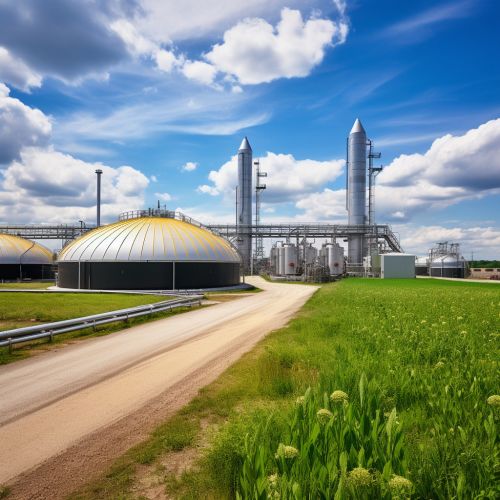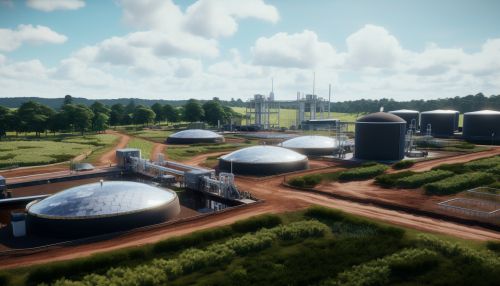Biogas
Introduction
Biogas is a type of biofuel that is naturally produced from the decomposition of organic waste. The waste material, which can include manure, plant material, sewage, municipal waste, and food waste, is broken down by microorganisms in an anaerobic environment. The resulting biogas is composed primarily of methane, carbon dioxide, and small amounts of other gases.


Production
The production of biogas involves a process called anaerobic digestion. This is a series of biological processes in which microorganisms break down biodegradable material in the absence of oxygen. The process is used for industrial or domestic purposes to manage waste and/or to produce fuels.
Feedstock
The feedstock for biogas production is typically organic waste material. This can include agricultural waste, such as manure and crop residues, municipal solid waste, such as food waste and yard waste, and industrial waste, such as waste from food processing plants and breweries. The type and quality of the feedstock can significantly affect the quantity and quality of the biogas produced.
Anaerobic Digestion
Anaerobic digestion is a complex process that involves four main stages: hydrolysis, acidogenesis, acetogenesis, and methanogenesis. In the first stage, hydrolysis, large organic molecules are broken down into smaller molecules by enzymes. In the second stage, acidogenesis, these smaller molecules are further broken down into volatile fatty acids and alcohols. In the third stage, acetogenesis, the volatile fatty acids and alcohols are converted into acetic acid, carbon dioxide, and hydrogen. Finally, in the fourth stage, methanogenesis, the acetic acid, carbon dioxide, and hydrogen are converted into methane and carbon dioxide, which make up the majority of the biogas.
Composition
Biogas is primarily composed of methane and carbon dioxide, with small amounts of other gases such as hydrogen, nitrogen, and hydrogen sulfide. The exact composition of biogas can vary depending on the feedstock and the conditions of the anaerobic digestion process.
Methane
Methane is the main component of biogas and is the gas that gives biogas its energy content. Methane is a potent greenhouse gas, with a global warming potential 25 times greater than that of carbon dioxide over a 100-year period. However, when methane is burned to produce energy, it is converted into carbon dioxide, which has a much lower global warming potential. Therefore, capturing and using methane from organic waste to produce biogas can help to reduce greenhouse gas emissions.
Carbon Dioxide
Carbon dioxide is the second most common component of biogas. While carbon dioxide does not have an energy content like methane, it is important in the anaerobic digestion process. The carbon dioxide produced during anaerobic digestion helps to maintain the pH balance of the digester, which is crucial for the microorganisms that produce the biogas.
Uses
Biogas can be used in a variety of ways, depending on its quality and the specific needs of the user.
Heat and Power Generation
One of the most common uses of biogas is for heat and power generation. Biogas can be burned in a combined heat and power (CHP) unit to produce electricity and heat. The electricity can be used to power the biogas plant itself or it can be fed into the electrical grid. The heat produced can be used for heating buildings, for industrial processes, or for heating the anaerobic digester to maintain the optimal temperature for the microorganisms.
Vehicle Fuel
Biogas can also be used as a vehicle fuel. Before it can be used in vehicles, the biogas must be upgraded to remove the carbon dioxide and other impurities. The resulting product, known as biomethane, has a higher energy content than raw biogas and is comparable to natural gas. Biomethane can be used in vehicles that have been designed or modified to run on natural gas.
Cooking Fuel
In many developing countries, biogas is used as a cooking fuel. Small-scale biogas plants can be built to process household waste and produce biogas for cooking and lighting. Using biogas for cooking can help to reduce reliance on traditional biomass fuels, such as wood and charcoal, which can have negative impacts on the environment and human health.
Environmental Impact
The production and use of biogas can have significant environmental benefits.
Waste Management
One of the main benefits of biogas production is that it provides a sustainable way to manage organic waste. Instead of being sent to landfill, where it would decompose and release methane into the atmosphere, the waste is used to produce biogas, which can be used as a source of renewable energy.
Greenhouse Gas Emissions
The production and use of biogas can also help to reduce greenhouse gas emissions. When organic waste decomposes in a landfill, it releases methane, a potent greenhouse gas. By capturing this methane and using it to produce biogas, we can prevent it from being released into the atmosphere. In addition, when biogas is used to replace fossil fuels, it can help to reduce carbon dioxide emissions.
Energy Security
Biogas production can also contribute to energy security. Unlike fossil fuels, which are finite and subject to price volatility, biogas is a renewable resource that can be produced locally from a variety of waste materials. This can help to reduce dependence on imported energy and increase the resilience of the energy system.
